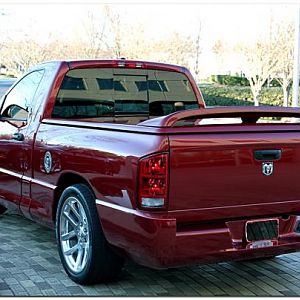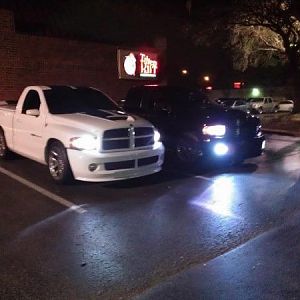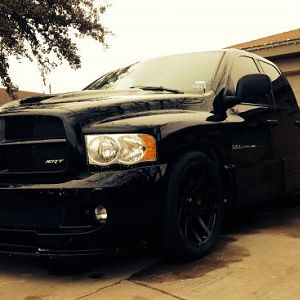OCBob
VIPER POWERED
More than 5 million vehicles on U.S. roads today can run on ethanol - a renewable fuel that comes from corn - as well as gasoline. General Motors (Charts), Ford (Charts) and DaimlerChrysler (Charts) recently announced plans to double their annual production of so-called flex fuel vehicles to two million cars and trucks by 2010.
It's the single largest commitment to renewable fuels in the history of the auto industry - a good move for the automakers, and for the planet, too.
Gas stations where you can purchase ethanol are few and far between today.
That's because running cars and trucks on E85, a blend of 85 percent ethanol and 15 percent gasoline, could turn out to be a cost-effective way to reduce the carbon emissions that cause global warming and curb our dependence on imported oil.
There's just one big problem.
Only about 800 service stations in the United States, out of a total of 168,000, pump E85. There's not a single E85 pump, for example, in all of New England.
You won't be surprised to learn that the big oil companies are not, as a rule, interested in selling E85.
But Wal-Mart (Charts) is. The giant retailer is considering selling ethanol at the eight stations that it operates at Wal-Mart Stores and at about 380 more that it runs as part of its Sam's Clubs division.
It could also decide to sell ethanol in a partnership with Murphy Oil Corp. (Charts), which operates about 946 gas stations in Wal-Mart parking lots, and there's no reason why Wal-Mart couldn't sell E85 - which it calls "America's Fuel" - at the rest of its 3,000 U.S. stores.
"Our goal would be to make E-85 available across the U.S.," Rich Ezell, senior strategy manager of fuel at Wal-Mart, said recently.
Why does Wal-Mart want to get into the transportation fuel business?
Several reasons. First, selling ethanol could be a new profit center for Wal-Mart, since the retailing business is wide-open. It's also a way for the company to help its customers save money; the less money they pour into the tank, the more they have to spend at Wal-Mart.
Finally, Wal-Mart's interest in alternative fuels like ethanol comes as part of its sweeping efforts to adopt business practices that are better for the environment. To guide its efforts, Wal-Mart has organized more than a dozen "sustainable value networks" that are composed of suppliers, environmentalists, industry experts and government officials.
The company brought an impressive group of movers-and-shakers to the kickoff meeting of its alternative fuels network in Washington last May. Participants included representatives of GM, Ford and DaimlerChrysler, the National Corn Growers Association, ethanol-makers such as Cargill, Blue Fire Ethanol and Iogen, consulting firms Green Strategies, BluSkye and the Rocky Mountain Institute, and nonprofits Conservation International, Environmental Defense, the Natural Resources Defense Fund, the World Wildlife Fund and the Worldwatch Institute. For most of a day, they discussed how Wal-Mart could help promote alternative fuels.
Afterwards, one longtime ethanol advocate told me that Wal-Mart - if it agrees to distribute E85 - could be a catalyst to making ethanol a mainstream alternative to gasoline for millions of Americans.
"That would be a complete game-changer," said Reid Detchon, the executive director of the Energy Future Coalition. "Everybody knows where the local Wal-Mart is. You would immediately know where to buy E85."
But Wal-Mart isn't ready to commit to ethanol yet, insiders say.
Before doing so, the company needs to feel confident that it will have access to ample supplies of ethanol, at a price competitive with gasoline. That's a complicated matter - prices for ethanol spiked this summer, even as lots of new supply is coming into the market. Wal-Mart is also waiting for ethanol dispensers to get certified by the Underwriters Laboratory, which tests products for safety.
Some other key issues need to be resolved before millions of Americans regularly fill their tanks with ethanol. (For more, see How To Beat the High Cost of Gasoline. Forever!)
Many experts believe that so long as ethanol comes from corn kernels or sugar cane, using ethanol for fuel will create stresses on the world's food supply; they favor what's called cellulosic ethanol, which can be made from prairie switchgrass, corn husks or other waste products.
Mass production of cellulosic ethanol isn't expected for a couple of years. Transporting ethanol from farm country to population centers is another challenge. There's also debate over the future of a 51-cent a gallon government subsidy for ethanol.
Consumers also need to learn more about the fuel. The auto industry's working on that. You've probably seen GM's clever "Live Green, Go Yellow" ad campaign, which can be found online.
GM's also been trying to help build an ethanol infrastructure. In California, Texas, Pennsylvania and several Midwestern states, the automaker has helped bring together ethanol refiners, governments and independent service stations to sell E85. Those selling the fuel include Meijer supermarket chains and the Sheetz convenience store chain.
The National Ethanol Vehicle Coalition keeps a list of E85 stations online. Philip J. Lampert, the executive director, says the number of stations has doubled in the past two years. "It's still just a drop in the bucket, but we're making significant progress," he says.
All this leaves people like Reid Detchon - who has worked on ethanol issues since the 1980s, and served in the energy department in the first Bush administration - feeling like ethanol's moment may finally be here. Particularly if Wal-Mart gets on board, Detchon says: "If oil stays at anything like these prices, I think ethanol will grow as fast as the farmers can produce it. We are on the cusp of a fundamental change."
It's the single largest commitment to renewable fuels in the history of the auto industry - a good move for the automakers, and for the planet, too.
Gas stations where you can purchase ethanol are few and far between today.
That's because running cars and trucks on E85, a blend of 85 percent ethanol and 15 percent gasoline, could turn out to be a cost-effective way to reduce the carbon emissions that cause global warming and curb our dependence on imported oil.
There's just one big problem.
Only about 800 service stations in the United States, out of a total of 168,000, pump E85. There's not a single E85 pump, for example, in all of New England.
You won't be surprised to learn that the big oil companies are not, as a rule, interested in selling E85.
But Wal-Mart (Charts) is. The giant retailer is considering selling ethanol at the eight stations that it operates at Wal-Mart Stores and at about 380 more that it runs as part of its Sam's Clubs division.
It could also decide to sell ethanol in a partnership with Murphy Oil Corp. (Charts), which operates about 946 gas stations in Wal-Mart parking lots, and there's no reason why Wal-Mart couldn't sell E85 - which it calls "America's Fuel" - at the rest of its 3,000 U.S. stores.
"Our goal would be to make E-85 available across the U.S.," Rich Ezell, senior strategy manager of fuel at Wal-Mart, said recently.
Why does Wal-Mart want to get into the transportation fuel business?
Several reasons. First, selling ethanol could be a new profit center for Wal-Mart, since the retailing business is wide-open. It's also a way for the company to help its customers save money; the less money they pour into the tank, the more they have to spend at Wal-Mart.
Finally, Wal-Mart's interest in alternative fuels like ethanol comes as part of its sweeping efforts to adopt business practices that are better for the environment. To guide its efforts, Wal-Mart has organized more than a dozen "sustainable value networks" that are composed of suppliers, environmentalists, industry experts and government officials.
The company brought an impressive group of movers-and-shakers to the kickoff meeting of its alternative fuels network in Washington last May. Participants included representatives of GM, Ford and DaimlerChrysler, the National Corn Growers Association, ethanol-makers such as Cargill, Blue Fire Ethanol and Iogen, consulting firms Green Strategies, BluSkye and the Rocky Mountain Institute, and nonprofits Conservation International, Environmental Defense, the Natural Resources Defense Fund, the World Wildlife Fund and the Worldwatch Institute. For most of a day, they discussed how Wal-Mart could help promote alternative fuels.
Afterwards, one longtime ethanol advocate told me that Wal-Mart - if it agrees to distribute E85 - could be a catalyst to making ethanol a mainstream alternative to gasoline for millions of Americans.
"That would be a complete game-changer," said Reid Detchon, the executive director of the Energy Future Coalition. "Everybody knows where the local Wal-Mart is. You would immediately know where to buy E85."
But Wal-Mart isn't ready to commit to ethanol yet, insiders say.
Before doing so, the company needs to feel confident that it will have access to ample supplies of ethanol, at a price competitive with gasoline. That's a complicated matter - prices for ethanol spiked this summer, even as lots of new supply is coming into the market. Wal-Mart is also waiting for ethanol dispensers to get certified by the Underwriters Laboratory, which tests products for safety.
Some other key issues need to be resolved before millions of Americans regularly fill their tanks with ethanol. (For more, see How To Beat the High Cost of Gasoline. Forever!)
Many experts believe that so long as ethanol comes from corn kernels or sugar cane, using ethanol for fuel will create stresses on the world's food supply; they favor what's called cellulosic ethanol, which can be made from prairie switchgrass, corn husks or other waste products.
Mass production of cellulosic ethanol isn't expected for a couple of years. Transporting ethanol from farm country to population centers is another challenge. There's also debate over the future of a 51-cent a gallon government subsidy for ethanol.
Consumers also need to learn more about the fuel. The auto industry's working on that. You've probably seen GM's clever "Live Green, Go Yellow" ad campaign, which can be found online.
GM's also been trying to help build an ethanol infrastructure. In California, Texas, Pennsylvania and several Midwestern states, the automaker has helped bring together ethanol refiners, governments and independent service stations to sell E85. Those selling the fuel include Meijer supermarket chains and the Sheetz convenience store chain.
The National Ethanol Vehicle Coalition keeps a list of E85 stations online. Philip J. Lampert, the executive director, says the number of stations has doubled in the past two years. "It's still just a drop in the bucket, but we're making significant progress," he says.
All this leaves people like Reid Detchon - who has worked on ethanol issues since the 1980s, and served in the energy department in the first Bush administration - feeling like ethanol's moment may finally be here. Particularly if Wal-Mart gets on board, Detchon says: "If oil stays at anything like these prices, I think ethanol will grow as fast as the farmers can produce it. We are on the cusp of a fundamental change."





